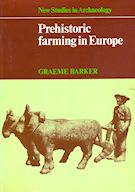Plant remains like carbonized cereal grains show what crops were grown, whether fallowing or rotation was practised and whether farmers kept all their harvest or traded some of it. The surrounding landscape of fields and forests can be reconstructed from environmental data. The huge areas of prehistoric fields in northern Europe are evidence not only of farmers’ organization of crops and stock but also of cooperation or competition over land. Differences in settlements, graves, tools and weapons document the changes in social complexity which were the essential context of agricultural change.
The development of these techniques has been accompanied by equally important changes in archaeological theory: in our view of prehistoric societies and our understanding of the processes which allowed the change from hunting to farming, a fundamental milestone in human development, some 10,000 years ago.
All this is drawn together in Prehisioric farming in Europe to provide the first modem synthesis of this story. Graeme Barker develops his argument through analogies with the agricultural history of classical and medieval Europe, and concludes that today’s industrial farmers can learn much from the successes and failures of early European farming.
